
Roller blinds are a special cloth that is wound on a small shaft. Such products come in several types, which allows you to choose them for almost all interior styles. The operation of these systems provides a mechanism for roller blinds. The duration and reliability of operation depend on its quality.


Basic concepts
A feature of roller blinds is that their height is regulated by winding. In this case, the canvas can move in several ways:
- Direct. The fabric falls remotely from the glass, closing the roll.
- Reverse. When lowering, the canvas passes as close to the glass as possible.
Curtains can also be supplemented with special guides that make it easy to lower the canvas. The mechanism itself for roller blinds consists of several structural parts:
- Round shaft. The diameter of this device depends on the size of the web and its thickness. They make it from aluminum or steel, which can work for a long time without the need for repair.
- Drive. This part is an element by which the shaft moves. Moreover, the design is designed so that the pipe can rotate in different directions. Management of such a system can be organized by mechanical or automatic action.
- Protective box. This part is optional, but is present in many products. It not only protects the device, but also decorates the frame of the mechanism.
Such products are often installed on plastic windows.


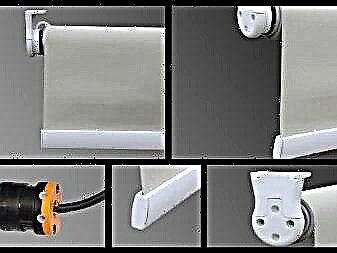
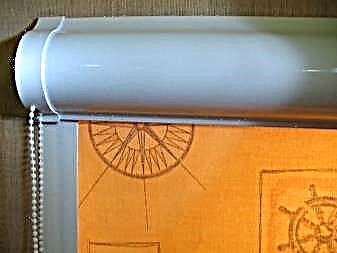
Rope type
This kind of mechanism is the simplest and consists of several elements:
- Rope. It connects to the main ropes in horizontal blinds.
- Roller. With its help, the force is transmitted from the control thread to the web frame.
The adjustment process is quite simple and involves shortening the length of the threads that are between the individual elements. In this case, the canvas is simply compressed into a kind of accordion. If this approach is applied to a single sheet of fabric, then folds form on its surface. This type of blinds is called Roman blinds.
The rope mechanism can be easily built independently. To do this, rings are sewn to the fabric on the sides through which the threads pass. The latter are attached to the bottom of the curtains.
Height adjustment is carried out by uniformly pulling the lower layer of the web and fixing the supporting thread on special hooks.


Ball control
The mechanisms of this type are based on the movement of a special chain, which drives the shaft. Chain designs require a special drum that can transmit forces to the pipe. It can be located on any end of the curtain (right or left).
The chain itself is made in the form of small balls that are fastened with thread. Between these elements there is a small space that is the same everywhere. On the surface of the drive drum are special grooves into which the balls fall. The design of the mechanism involves a tight docking of these elements.
The movement of the shaft is due to the impact of balls on the drum. It resembles a kind of bicycle transmission, but with a different kind of chain. To wind the curtains, you need to move the chain in one direction, and for lowering - in the other. In this case, the length of the thread should be approximately equal to 2/3 of the length of the curtain.
Among the shortcomings can be distinguished by the fragility of the design. This is due to the fact that many mechanisms are made of plastic, which is quickly erased. But almost all chain models can be easily replaced. This makes this mechanism one of the most sought after and popular.
To extend the life of this device, do not move the chain in sharp jerks, as it may break.


Spring mechanism
Designs of this type are externally very attractive, since they lack additional control systems. Many install such curtains in offices or bedrooms. The mechanism itself is quite simple and requires a spring that is connected to the shaft. Moreover, in one of the positions (top or bottom), it can be stretched, while in the other it can be almost without tension. This allows you to place these mechanisms both above and below the sash.
Curtains with this mechanism are perfect for several types of windows:
- swing-out,
- vertical
- ceiling
- mansard (made of plastic).


Please note that the angle of the frame does not play any role, which is impossible to say about other types of blinds.
The web can be fixed in several main ways:
- A pen. This system is connected to special stops that can hold the curtain. To fix the product, simply turn the knob to the desired position.
- Retaining ball. This element is located directly on the shaft. However, it allows you to easily move the canvas down. To fix the tissue, you should simply sharply move it up. This will cause the ball to close the passage and the system will no longer move.
- Hooks The easiest and most common way. To prevent lifting, the lower part of the canvas simply clings to the hook. These elements are often located along the entire length of the window sash.
The main disadvantage of the spring mechanism is its fragility. This is due to the fact that the spring quickly stretches and loses its original properties. Therefore, many do not recommend installing such curtains in a house where there are small children.


Automatic
Today, a person tries to simplify his life as much as possible by transferring his responsibilities to mechanisms. This led to the fact that as a drive in roller blinds Inspire began to use electric motors. Such mechanisms are much more complicated than those described earlier, although the principle of their operation has remained unchanged.
The movement of the shaft is controlled by an electric motor that acts on a special gear.
Please note that it is not difficult to change direction here, since you just need to change the power supply poles and make the engine spin in the other direction.

Management of these systems can be of several types:
- Stationary. To do this, install several buttons near the window that transmit signals to the main mechanism.
- Remote. The controller and receiver are already used as a regulator, which converts the received signal into appropriate commands.
- Automatic. The most complex and expensive mechanism. It includes not only the engine and shaft, but also several sensors. They respond to lighting and, at a certain value, start the engine on their own.




This type of mechanism is gaining more and more popularity. But at the same time it is quite expensive and not everyone can afford to buy such curtains. The disadvantage of the design is the complexity of the repair, which cannot be carried out independently.
Each of the considered mechanisms for roller blinds has its own unique features and technical characteristics. When choosing these products, it is important to consider not only their technical equipment, but also the installation location.
You can see the mechanism of the roller blind in the next video.
Features
A variety of roller blinds allows you to use them everywhere, harmoniously fitting into the interior. The comfort created with their help is incomparable with that which ordinary tulle can give. But for most consumers, the roller blind is still not very familiar, and this gap must be filled.

Choosing the best option in the store, you need to think not only about how it will look on the window and how well it will protect from glare rays, but also about its fastening.
Almost always, curtains will have to be hung on plastic windows, and this can be done in several main ways.
Choosing a control method
The decision on the method of fastening is made taking into account what the window opening itself is. Ignoring this point, you can ruin even the most excellent design. Roller blinds are relatively small and easy to use, because they use carefully thought out mechanisms.
They are divided into the following types:
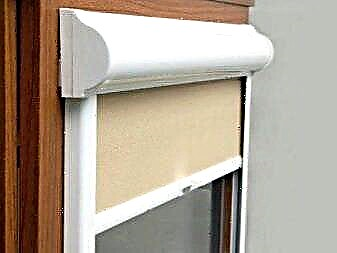

A mini-cassette made of aluminum is inserted inside the guide - there are no special differences from the blinds device. Roller blinds with a spring mechanism cannot be confused with automatic ones: they are retracted or unwound only due to the fact that they are mounted on inclined surfaces. No electric drives are needed, the mini-cassette can be fixed to a special adhesive tape that does not leave traces. It is set very quickly, and there is no need to drill anything.

A full-format cassette differs from a miniature one in that the twisted curtain completely goes inside, and in the expanded state it covers the opening, and not just the glass. Suspended plastic chain provides relatively accurate web control.
The automated device is equipped with an electric motor that controls automation and remote controls.
Mechanism options for rolshtor
For ease of operation, several types of mechanisms for controlling curtains have been developed.
- Cassette mechanism. An aluminum cassette is inserted into the guide. This design allows you to close the entire window frame, because fully consistent with the shape and size of the mechanism on which the blinds are mounted. Mounted most often on the wall. The advantage is that such curtains do not let a single ray of light into the room, and the system is very easy to use. If necessary, it is possible to repair it yourself. It can be installed on both plastic windows and wooden. Such curtains will not interfere with fabric curtains fixed on ordinary curtains.
see also: Examples of horizontal cassette blinds
- Spring mechanism. Closing and opening of the roll is due to the action of the spring. Installation of such a system is possible only on a sloping surface, and the service life is usually short-lived. As a rule, manufacturers of such curtains give a guarantee for a certain amount of opening / closing of such curtains, this is due to the unreliability of the device. But perfect for installation in rooms where they will rarely be used. Among the advantages - semi-automatic closing - opening, requiring only a small push by hand.

Where: 1 - mount, 2 - spring mechanism, 3 - mechanism lock in the pipe, 4 - plug.
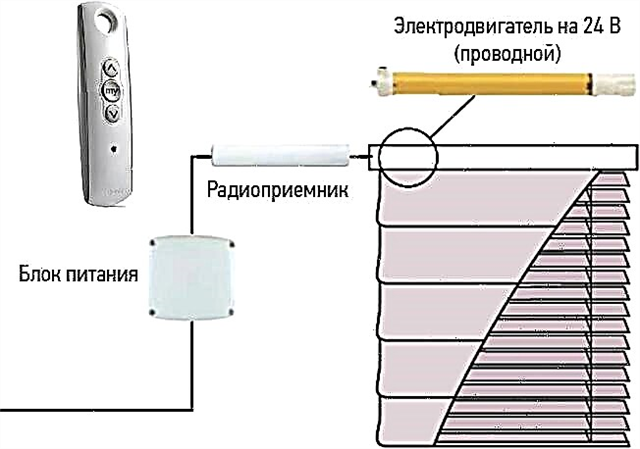
What is the mechanism for roller blinds made of?
Roller blinds are a very convenient solution for creating twilight in a room in the morning or in the evening hours, as well as for diffusing daylight bright sunlight and protecting against them. In the rolled state, such curtains are almost invisible, and the lowered canvas does not take up much space.
Installation of the device is not particularly difficult - the structure is mounted on the frame, it is fixed with a special strong adhesive base. The whole structure consists of several parts:
- dense fabric - a fabric that protects from sunlight,
- the shaft on which the fabric is wound,
- a chain located on the side of the canvas, with the help of which the fabric is folded and fixed,
- side profiles that provide the desired location
- plumb line, which will help to avoid wrinkles on the canvas and ensure its smooth surface.
The system is mounted on walls or on the ceiling, or on the window frame. The simplest option in this case - fastening to the window frame - does not require drilling additional holes for the system, because it has an adhesive base. For mounting on a wall or ceiling, you will need several dowels and screws.

How to care for the canvas and the mechanism of roller blinds?
The mechanism and the entire system are designed so that it is easy to care for. Care in this case is required, because This will ensure the safety of your health and the duration of operation of the curtains. Timely washing, washing and lubrication of the system will extend the life of the roller blind.

Basic tips for operating the system:
- When buying blinds, you need to choose those that are coated with special solutions that allow you to repel dust, avoid deformation, are dense with constant lowering / raising and preserve the original color of the fabric from fading.
- Do not install the system near appliances that can heat up to high temperatures or have high humidity.
- Periodically clean the canvas by removing it from the structure. It should be remembered that washing fabrics made from natural fibers is prohibited. Such canvases can be options from bamboo, cane, linen or wood. To wash in an extreme case, when ordinary cleaning does not bring the desired result.
- When washing or otherwise removing dust, pay particular attention to creases on the fabric, creases and other damage, if any. It is better to immediately replace the damaged fabric with a new one.
- To prevent the accumulation of dust, the appearance of mold and other harmful microorganisms, frequent ventilation of the room with the curtains lowered is necessary.
- It is necessary to manipulate the mechanism with the use of moderate force, so as not to damage it with a sudden movement or too strong a jerk.
- The mechanism needs periodic treatment with lubricants containing silicone or oil. This can extend its life.
- Timely cleaning of the room prevents excessive settling of dust on the canvas, which will also extend the life of the roller blind.

- If any part of the mechanism suddenly fails, then it can be easily replaced by buying in a store. As a rule, replacement parts and accessories for such mechanisms are sold in large construction stores.
How does the roll mechanism work?
The main element of the roll devices is a bar having a circular cross section, its task is to raise or lower the curtains: partial or full. This is achieved with a cord that drives the shaft in motion. To fix the straightened fabric, a weighting agent is provided in the design. Cords, ribbons or other similar elements play the role of garters. The location of the bar may be different. In some models, it is located below, at the same time fulfilling the duties of the load; in other designs, the shaft is attached to a frame or cornice.
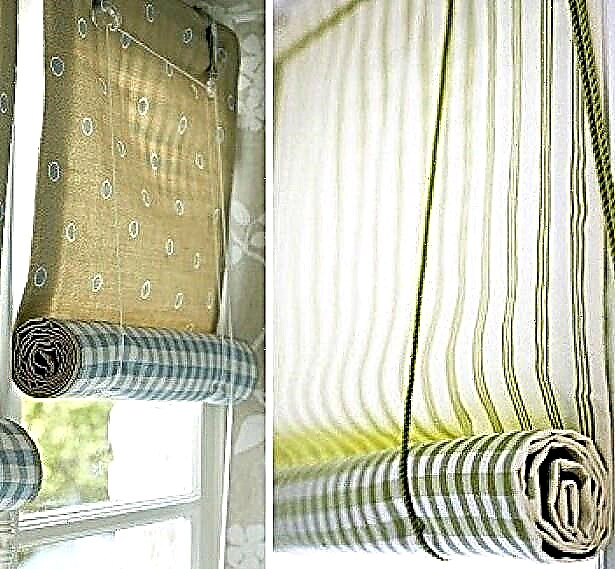
Despite the same principle of operation, roller blinds are somewhat structurally different. Some models are equipped with additional elements that are required to improve the appearance, make operation more comfortable. To protect the fabric from dust, some models are equipped with closed roller boxes. Practical shutters are equally popular, in which magnetic tapes or guides are provided to prevent distortions of fabric rolls.
Advantages and disadvantages
Spring mechanics with all the external spectacularity is not reliable enough. No wonder manufacturers give a guarantee only for a certain amount of time. Especially quickly springs wear out and fail in the house, where children can reach them. To bring the curtain to the desired position, it is moved, holding on to the lower edge.
In different models, this function can be implemented in one of three ways:
The handle mounted in the bar, at the moment of rotation, sets the stops of the guides in motion, and the web is wound on the shafts,
A brake ball is provided inside the shaft (to start the promotion, the curtain is slowly pulled down half a turn, and to fasten, push up until it clicks)
In the course of the curtain, hooks are delivered - this option is easy to execute and very reliable.


It is possible to put roller blinds with spring control even on a ceiling, tilt-and-turn or dormer-window. The angle of its location relative to the sex does not play a role. An important nuance: the presence of a ball in the drum requires you to push and lift the canvas very carefully. Excessive force can disable the sensitive apparatus prematurely.
A roller blind with a chain mechanism is more practical than others. The fabric is wound on a bobbin connected with a drum, in its grooves pass a chain of plastic and a retainer. One has only to move the chains in the right direction, as the rotation of the drum lowers the matter or raises it. Everything is simple, and anyone can use such a device.


The negative side of this option is the low reliability of the parts made of plastic: the latch breaks pretty quickly, the material is dry, especially if it is heated by the sun. Sooner or later, the moment comes when the chain breaks. But buying spare parts is not difficult. The chain length cannot be less than 2/3 of the entire length of the curtains.
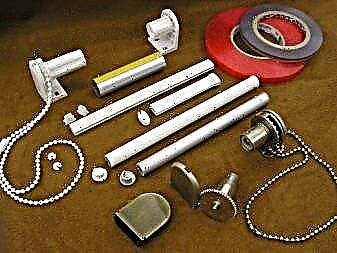

In terms of reliability and simplicity, the cassette type of the mechanism has no analogues. It is possible to block the entire opening, and it does not matter, plastic, wooden or aluminum windows are installed in the house, since they fix the device above them. It is possible to put the cartridge on the frame itself, having closed it with a pony from prying eyes.

An advantage is compatibility with conventional curtains.
Fixation
Any type of such mechanisms unwinds or unwinds the canvas, fixing it in a given position. The rotation axes are attached both from above and from the bottom of the window, sometimes they move completely at the same time as the roll, the outer edge of which is fixed. The fabric can be wound onto the shaft either directly (the roll cannot be seen) or in the opposite way (in which the roller blinds go tight to the glass).
When you need a smooth ride and a reliable fit to the dormer-window (or when ventilating the usual), use guides. Flat guides prevent the lower bar from deviating from the desired path. The disadvantage of this solution is the ability to use them only on flat areas. Where the surface is not perfect, put U-shaped guides with a profile of increased rigidity. Thanks to them, the ends of the matter are closed tightly and let in a minimum of light.

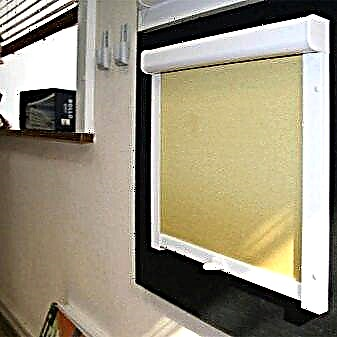
Magnetic fixation of the lower planks in the fully opened state is a characteristic feature of innovative roller blinds. When they are partially deployed, the canvas is held by vertical fishing lines (open or located behind the fabric).
An electric motor is only needed in special conditions. - in large halls, with a very high ceiling, on a stained glass window. Then mechanized drives on the ropes, controlled remotely, and can reveal all their "talents". In ordinary homes, using them is an empty waste of money.
The design of the mechanism, as we have already seen, can be very different. And its working principle slightly affects the dimensions, the size of the suspended coil is much more important. Since the winding shaft is just a hollow tube made of aluminum, it is unacceptable that it bend under the weight of the fabric. The cassette placed from below will help to pull a cloth on glass from bottom to top.

Using roller blinds, divided into two rolls, you can leave a gap between them if necessary. Closed control systems (with a box hiding control elements) are more expensive, but also more reliable. The main material is not deformed, the risk of sagging is reduced. We emphasize that no matter what mechanism of lifting the roller curtains you choose, it should work without a single sound. Having discovered the slightest noises, it is necessary to prepare for their repair.
The roller blind fits perfectly into the modern trends of minimalism and simplicity, it will appeal to everyone who likes convenient and comfortable interior details.
Knowing how the mechanisms governing its work are arranged, you will not make mistakes when choosing them in a store or in a catalog and you will know exactly what is right for you and what types of roller blinds are compatible with a particular window.
You can find out how to install roller blinds yourself from the video below.
What will outweigh: pros or cons
Before planning the construction of a mechanism for roller blinds with your own hands, it is necessary to comprehensively assess the feasibility of such a solution. Therefore, it will be useful to show the advantages of the Rolshtor, but at the same time poke a finger at their shortcomings. Advantages with which many will agree:
- reliable protection against prying eyes due to a snug fit to the opening,
- ease of installation on the cornice, frame of any window: both plastic and wooden,
- maximum free space that traditional curtains cannot boast
- two roles at once performed by roller blinds, because in addition to curtains they are used as fabric blinds,
- the possibility of combination with other similar products - lambrequins, drapes, tulle.

This can also include savings, if you plan to independently manufacture rolled curtains, since materials, including textiles, will require very little.
Disadvantages, alas, are present in everyone and everything, shutters are no exception. Among the "spoons of tar":
- insufficient variability of light intensity control, which distinguishes blinds from blinds,
- potential malfunctions if a simple model without guides is selected.
These disadvantages are unlikely to outweigh the many advantages, this difference is the secret to the success of these designs. Roller blinds can be found at every step: in apartments, private houses, shopping centers, enterprises and offices.
Types of designs
When planning to build a mechanism for roller blinds with your own hands, you need to get acquainted in advance with the design features of the roller blind. There are several types of lifting devices, each of which has both advantages and disadvantages. Their types:

- Spring loaded. These mechanisms can be installed below or above the curtains. The advantage is that there is no need to manipulate the holders, since all work is performed automatically - with the help of a spring. However, the minus lies precisely in these details, this is their quick wear, so their frequent replacement will be required.
- Chain - the simplest, almost failure-free design. The curtains in them are regulated manually - by means of a rope, a chain of plastic or a cord. These elements, thrown over the bar, are fixed in the lower part of the canvas. When pulling the rope, the roller begins to rotate, lowering or raising the fabric. In this case, to fix the canvas in a certain position, holders (garters, clips) are needed. Here, it is the simplicity of the design that guarantees its durability. Another plus is the low cost.
- Electric drive systems. It is quite difficult to make such a mechanism for roller blinds with your own hands, since the design is equipped with an electric motor that opens and closes the curtains. Manipulations require a remote control or a switch. The advantage is ease of operation, the disadvantage (except for the complexity) is the high cost. Such lifting mechanisms are the only option for large openings - on panoramic or dormer-windows.

In this roll category, another type of curtain is mistakenly included - Roman. However, with all the external similarities, the difference is still great: roller shutters have a shaft on which the canvas is wound, and the "Romans" simply gather in folds.
After getting acquainted with potential designs, it becomes clear which mechanism for roller blinds to do with your own hands is the easiest way for a home master. The chain design will allow you to quickly get the necessary product, but at the same time spend a minimum of finance.
Roll Material
The first task is the choice of material. The simplest ones are wooden planks or slats, but in this case it will not be curtains, but blinds that transmit light well, but they will not help protect from light, and besides, they have solid weight. Therefore, this option is to the liking of a few.
In the role of fabric for such products often acts:

Another option is combinations. For example, polyester "in the company" with viscose, satin or cotton, fiberglass (fiberglass), screen (fiberglass and polymer threads). All given materials are practical, reliable, easy to erase. However, before buying, you need to consider that for different rooms there are "favorites."
- The living room, study and kitchen need thin fabrics that “dutifully” transmit light. For a kitchen room where the curtains get dirty especially quickly, this is a must.
- Children and bedrooms, on the contrary, need dense material, since protection from sunlight, as well as from the light of lanterns, is important.
In a living room, it is better to choose a material with an antistatic effect, able to withstand dust, reflecting heat. A fabric impregnated with an odor-reducing compound is ideal for kitchens.
Tools and items

The main task is the choice of material for the shaft. In this case, the assortment is large: it can be a bar made of wood or aluminum, a piece of cornice, a wooden beam with a cross section of 25-30 mm. Its length should be 15-20 mm shorter than the canvas, the last figures are the fabric allowances left at the seams.
The first step is measurements for roller blinds. After measuring the parameters of the frame, window, opening, or individual shutters, 150 mm are added to the obtained height, necessary for the shaft and weighting agent, and an allowance for seams of 30-40 mm (15-20 mm on each side). To width - only stocks for seams from each edge.

You will need a small set, which includes:
- fastening on an aperture or window frame: double-sided tape for plastic windows, a rail with metal corners (self-tapping screws) - for wooden structures,
- hooks, metal or plastic rings, a retainer (cord, tape), the length of which is three times the length of the future curtains,
- Velcro is the same size as the rail,
- a piece of fabric cut out after measuring the area of the frame,
- sewing machine.
Step-by-step instruction
Before assembling the roller blinds, they are sewing curtains. After cutting the fabric, a “bag” is sewn from it, it is turned on the front side and a section that is not stitched is sewn up.

- In that part, which will be the bottom of the curtains, they outline a pocket for a weighting agent, place an element there, and attach it to the machine. However, this can be done in different ways: leave both sides open, close only one so that the weighting agent can be easily removed in case of washing the curtain. The most impractical option is building up from all sides.
- The shaft rod is attached in several ways. The simplest is fixing with a furniture stapler (thread). An alternative is attaching to the canvas with Velcro, one part of which is sewn in advance to the fabric.
- Rings intended for a cord or tape are fixed at a certain distance from the sides and rods of the structure - 150-200 and 50-70 mm, respectively. To fix them, use two narrow strips of the same fabric. Another method involves making holes in the canvas, they are camouflaged with eyelets.
- Hooks are screwed into the weighting agent. The clips are tied to them, which are pulled along the canvas, leading through the rings, they are sewn at the top. The tape or cord is attached to the wall with a hook screwed into the wall. When pulling the tabs, the curtain roll will rise up and vice versa.
- The holder-bar is hung on the window - to the frame, the opening. In the marked places of the wooden frame, holes are made for screws or metal corners are fixed. If the window is plastic, use double-sided tape or plastic fasteners.
- The canvas is pulled over the attached shaft, the ends of the Velcro are combined, then the mechanism is suspended in its rightful place, tested. If the product is unfolding (rising) unevenly, a more massive “candidate” is sought for the role of weighting compound.
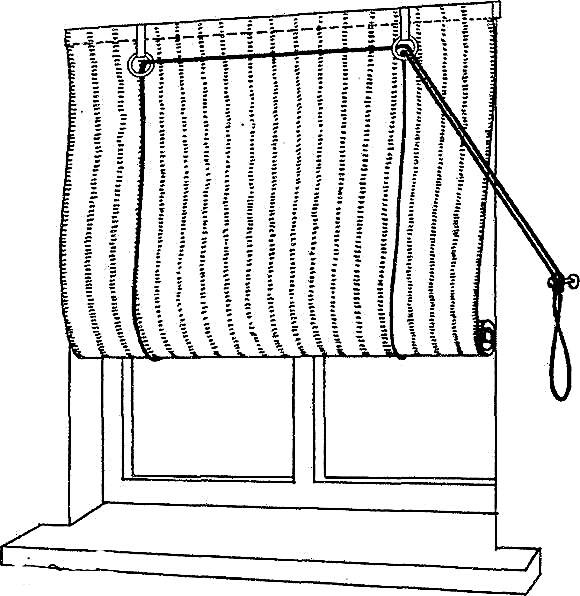
It is not difficult to build the simplest mechanism for roller blinds with your own hands, however, the quality of such crafts does not always suit the owners. If the independent production of the canvas is not inspiring, then it is easier to purchase a finished model or choose and order the one you like.
One of the ways to get the desired design can be found here:




